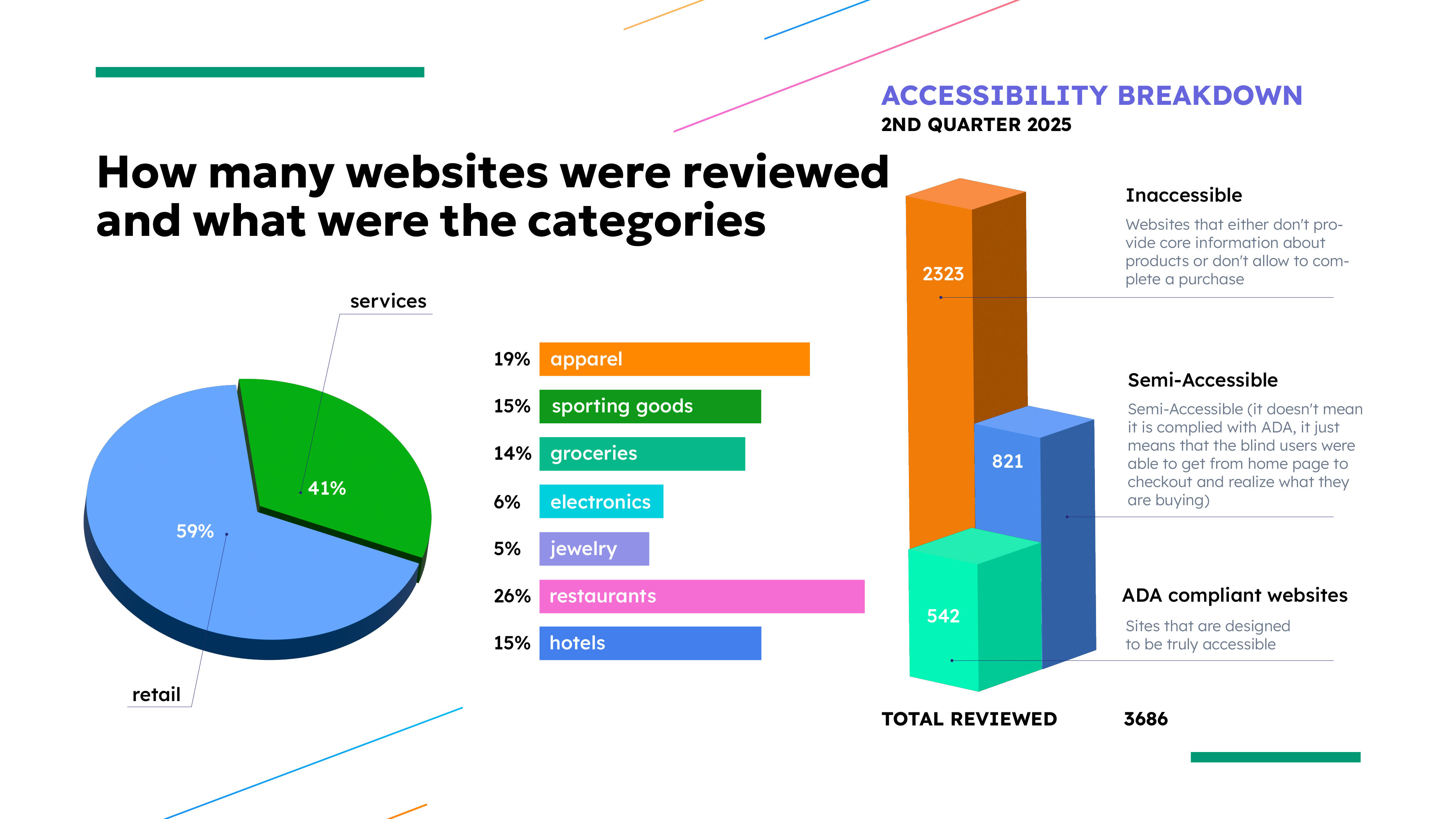
Accessibility Review for May - August of 2025
At AllyADA, it isn’t just our mission to boost accessibility through best-in-class digital audits; it’s also our mission to generate real-time statistics about the state of digital accessibility across the full spectrum of e-commerce. Our research provides insight and inspiration to supercharge the momentum toward building a commercial webscape that offers benefits to consumers and businesses by embracing inclusivity as a moral imperative and a smart, savvy business model.
Summary of Findings
We engaged with 3686 websites during this period to determine each website's level of accessibility compliance with the Americans with Disabilities Act (ADA) and draw conclusions about the categories of common accessibility issues present.

Inaccessible: A total of 2323 websites tested (63%) were deemed inaccessible, meaning that the websites lacked basic functionality or usability for blind and low vision users. For instance, they may fail to provide access to core information about products, fail to allow blind and low vision users to complete a purchase, or trap users in inescapable form fields.
Semi-Accessible: A total of 821 websites tested (22%) were deemed semi-accessible, meaning the websites were minimally accessible. For instance, blind and low vision users were able to navigate from the homepage to the checkout, with at least a base-level understanding of what they were buying, but critical accessibility failures still exist.
Fully Accessible: A total of 542 websites tested (15%) were deemed fully accessible, meaning the websites are ADA-compliant. Blind and low vision users are able to access and use all informational and navigational features on the website, including being able to obtain relevant information about products, locations, and working hours, find specific products, make selections for size and color, understand the purpose of each form field, move in and out of formfields, rely on keyboard navigation, or do things like book a table and select the time.
Recap of the Most Common Accessibility Issues
For anyone newly interested in digital accessibility or in need of a refresher, there are two standards for accessibility compliance online: the Americans with Disabilities Act (ADA) and the global Web Content Accessibility Guidelines (WCAG). A website is typically non-compliant with these standards if there are impediments to the site’s ease of use, navigation, comprehension, and purpose, as measured from the homepage through the checkout page (or comparable page if not directly applicable).
In other words…can someone who is blind or low vision, or who relies on alternative means of website navigation, actually use the site easily and optimally to do what it’s supposed to do?
Want to order dinner? Everyone should be able to look at the menu items, navigate the ordering process, and check out. Want to research interest rates on a personal loan? Everyone should be able to hop from site to site, easily gathering relevant information to aid in the decision-making process. Want to buy a sofa, send flowers, volunteer with a group that meets on Saturdays? Any of these things should be just as easy for blind and low vision users as it is for everyone else.
Here are the most common issues our testers encounter when assessing websites to determine whether they are fully accessible, partially accessible, or inaccessible.
- Lack of alt text for images: This error is marked by the absence of a textual description accompanying images. Alt text allows people who use screen readers to understand the content of the image.
- Pop-ups: This error refers to pop-up windows that appear on a webpage. Pop-ups can be disruptive to blind or low vision users and can also be difficult to close for users who use screen readers.
- Bypass blocks: This error refers to elements that can be used to bypass the main content of a webpage. This can be problematic for users who use screen readers because they may not be able to access the bypassed content.
- Form fields: This error refers to issues with form fields on a webpage. These issues can include missing labels, unclear error messages, or form fields that are not keyboard accessible.
- Inaccurate landmark structure: This error refers to the incorrect use of HTML landmark elements. Landmark elements identify the different sections of a webpage, such as the header, navigation, and main content.
- Inaccurate heading hierarchy: This error refers to the incorrect use of heading elements (H1, H2, H3, etc.). Heading elements are used to create a hierarchy of headings on a webpage, which can help users understand the structure of the content.
- Ambiguous link text: This error refers to link text that is not clear or descriptive. Link text should tell users what they can expect to find when they click on the link.
- No notification when moving to an external website: The move to an external website is usually signalled through visual confirmation, but for blind or low vision users, this can cause confusion by bumping them to an external website without notice.
Yes- digital accessibility is about ensuring basic equity to every day experiences online. But remember- since commerce is also part of the equation, digital accessibility is also about optimizing consumer experience, brand loyalty, business objectives, tax incentives, and market reach. And it’s always worth it!
Current Accessibility Insights
A review of our most recent statistics confirms that digital accessibility in the second quarter of the year continues to trend upward. Not only is there a notable increase in the number of websites becoming accessible in the first place, but we’re also seeing real progress with well-implemented examples of accessibility.
One of the most transparent examples of this trend is the movement away from superficial, quick-hit fixes toward authentic fixes. For instance, more and more businesses are choosing to implement accessibility through services like digital accessibility audits versus purchasing an overlay.
Audits allow developers to fix the fundamentals, to build accessibility into design from the foundation up, to center genuine accessibility as a core objective and a primary goal. By contrast, buying an overlay just continues the problem of implementing ineffective solutions that ultimately cause more accessibility problems than they fix. (Check out our take on these so-called “solutions” here.)
When you dive into the numbers below, you’ll see that most of the websites implementing accessibility belong to restaurants and large e-commerce stores. We suspect this is due to a combination of two things:
Large retail brands and restaurants represent categories of websites that rely on a broad range of consumers, rather than a niche subset. For instance, an online retailer that sells only running shoes will attract a very different consumer demographic than a large retail brand that sells a cross-section of shoes and a bunch of other things. Similarly, restaurants have a broad, universal appeal and attract consumers from every possible target demographic. The more people a website appeals to, the more accessibility matters!
- Midsize brands may think that accessibility targets are financially out of reach, and better left to the big guys.
Of course, at AllyADA, we couldn’t disagree more with this narrative. In fact, with affordable pricing for best-in-class digital audits, tax breaks for accessibility improvements, and increasing SEO and consumer engagement, accessibility isn’t just affordable for small to mid-size businesses, it’s a bottomline booster!
Most Common Categories of Websites with Accessibility Issues
Yes, big retail and restaurants continue to show the strongest trends toward real accessibility achievements, but this doesn’t mean that they aren’t also still coming in hot with accessibility violations, as well. After all, achieving large-scale accessibility is an ongoing process, not an overnight solution.
However, the overall breakdown of non-compliant websites showed that while the majority still (59%) fell into the “Retail” category and the remainder (41%) still fell into the “Service” category, this marks a significant shift from the prior quarter. In fact, the number of inaccessible Retail websites experienced a 12% drop, with a comparable increase for Service sites.
Here’s how we define the categories:
| Retail Websites | Service Websites |
| Devoted to the sale of physical goods and products, regardless of the nature of the goods. | Devoted to the provision of a specified service which allows prospective clients to make informed decisions, schedule services, make a reservation, etc., rather than purchase a good outright. |
| Examples include the sale of things like shoes but also the sale of food commodities like dry pasta and canned food. | Examples include websites for medical practices, law firms, restaurants, and hotels. |
There were also some slight, but expected fluctuations in the percentages involving the various types of retail and service sites that were not ADA-compliant. In Retail, the most non-compliant websites were Apparel (19%), Electronics (6%), Groceries (14%), Sporting Goods (15%), and Jewelry (5%). In Service, the most non-compliant websites were Restaurants (26%) and Hotels (15%).
How to Improve Your Website’s Digital Accessibility
Get a Digital Accessibility Audit
This is the starting point for any conversation about upgrading your website and business plan to include digital accessibility. If your business is in the early stages of planning a website, talking to a digital auditing firm can help you build accessibility from the foundation.
Implement the Remediation Steps
It may sound intimidating, but it’s not. A trusted auditor will provide clear, transparent, and easily understood feedback on the exact accessibility barriers and the exact steps that need to be taken in order to achieve ADA and WCAG compliance. Questions are answered. Reports are provided. And specialists are always available for follow-up.
Schedule Regular Follow-Ups!
Technology changes constantly. Web design changes constantly. User interfaces change constantly. Payment and navigation technology change constantly. Experiential elements change constantly. You get the drift. Accessibility isn’t a one and done scenario. It’s an ever-evolving process, but it doesn’t have to be intimidating.
Think of it like going to your doctor for an annual checkup. You may learn that everything is fine. You may learn that you need to schedule a procedure. Either way, having a standing date to check in is the key to ensuring a long, healthy, fully optimized existence. Regular digital audits play the same critical role for your website.
At AllyADA, this is what we do best. Schedule a call, then schedule an audit, then put us on the schedule for the future. It’s a no-fail plan to maximize your business benefits, grow your customer base, and prevent needless lawsuits and regulatory fines.
For now, we continue to increase the number of websites we review in order to improve our statistical reach. This quarter, we learned that accessibility continues to creep its way into the mainstream and that foundational design elements are hard at work- as opposed to fast, cheap fixes with overlays and widgets.
We celebrate this continued momentum and invite anyone who is interested in learning more to contact AllyADA today!
